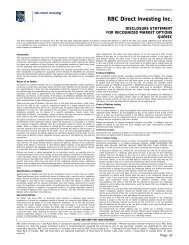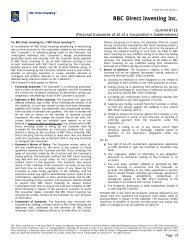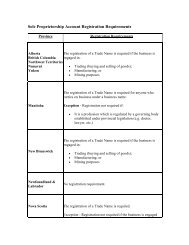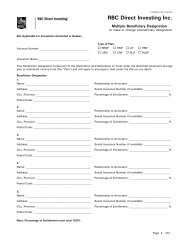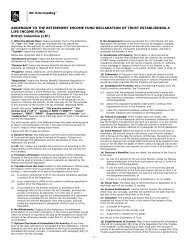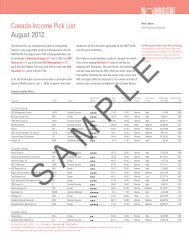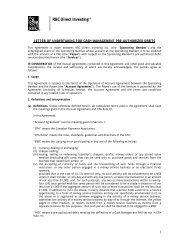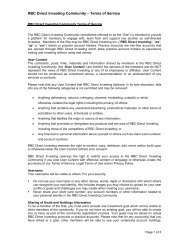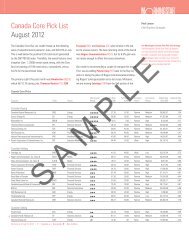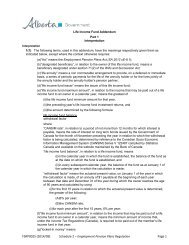View Sample PDF - RBC Direct Investing
View Sample PDF - RBC Direct Investing
View Sample PDF - RBC Direct Investing
Create successful ePaper yourself
Turn your PDF publications into a flip-book with our unique Google optimized e-Paper software.
Regional outlook – CANADA • Stuart Kedwell, CFA<br />
asset growth and the housing market,<br />
coupled with lower net-interest<br />
margins, remain key areas of investor<br />
focus.<br />
We continue to believe that a housing<br />
slowdown is manageable for the banks,<br />
although the loud debate will act as a<br />
brake on near-term valuations. As each<br />
bank prepares to meet Basel III capital<br />
thresholds in the next 12 months, the<br />
focus will eventually return to their<br />
considerable capital generation – even<br />
in a slow-growth environment. Returns<br />
on equity have proven resilient and<br />
the spread of these returns relative to<br />
those available from a 10-year bond<br />
remains attractive. Current dividend<br />
yields coupled with modest dividend<br />
growth should combine to provide<br />
satisfactory total returns.<br />
Insurers’ earnings have been weighed<br />
down by the growing consensus that<br />
interest rates will remain low for a long<br />
time. While the impact of low rates on<br />
earnings power could persist for several<br />
years, we believe insurance companies<br />
have enough capital and earnings<br />
capacity to weather this storm. From<br />
a portfolio standpoint, insurance<br />
companies provide some protection,<br />
since any rise in interest rates would<br />
negatively affect utility companies<br />
and real estate firms, and because we<br />
believe it’s doubtful that the insurers<br />
will need to raise additional equity.<br />
Valuation multiples in the Materials<br />
sector are unlikely to expand because<br />
of slowing growth in China. Yet at<br />
current commodity prices, the sector’s<br />
free cash flow is significant. We think<br />
the use of this cash in the next few<br />
years will be a key factor in the sector’s<br />
performance. As an example, we note<br />
that Potash Corp.’s healthy level of<br />
capital spending will start to tail off,<br />
leaving the company with strong freecash-flow<br />
generation even in a weaker<br />
commodity environment.<br />
Gold stocks lagged bullion again during<br />
the quarter as a number of companies<br />
continue to struggle due to high capital<br />
costs and operational issues. While<br />
the spread between traditional goldcompany<br />
valuations and bullion is at<br />
historically wide levels, some share<br />
prices are starting to look attractive on<br />
a free-cash-flow basis.<br />
Stocks of companies in the Energy<br />
sector continue to trade below levels<br />
one would expect given expectations<br />
for commodity prices. There are a<br />
number of reasons for this trend.<br />
Regional price differences have been<br />
elevated this year, and rising operating<br />
and capital costs continue to be a<br />
concern. As in the Materials sector,<br />
investors are highly focused on capital<br />
discipline. Stock valuations suggest<br />
that many energy companies will find it<br />
more attractive to buy back shares than<br />
embark on new projects.<br />
On the natural gas front, new drilling is<br />
finally beginning to slow in response<br />
to a very warm winter and weakness<br />
in prices for natural gas liquids. With<br />
an abundance of natural gas in North<br />
America and extremely low prices for<br />
gas relative to the amount of energy<br />
produced versus oil, the market is<br />
waiting for a concrete and sustainable<br />
demand response to help prices.<br />
A positive near-term surprise has<br />
been the increasing use of natural<br />
gas instead of coal for electricity<br />
generation, which has helped ease<br />
concerns about a lack of storage<br />
this summer. We expect gas to trade<br />
between $3.50 (the cash cost of<br />
production) and $4.50 (the marginal<br />
cost with a return on capital).<br />
Research In Motion has been a volatile<br />
stock as investors debate the value<br />
of an uncertain stand-alone business<br />
against a large patent portfolio and $4<br />
per share of cash representing about<br />
40% of its market value.<br />
Canada’s Industrials sector offers<br />
a number of opportunities where<br />
current share prices appear to offer<br />
good returns in a slow but steady<br />
growth economy. Should earnings<br />
at companies like Canadian Pacific<br />
and Finning progress in a reasonable<br />
manner in the years ahead, and the<br />
multiple paid on those earnings fall<br />
within historical bands, the share-price<br />
appreciation potential for both would<br />
be attractive.<br />
SAMPLE<br />
The global investment outlook <strong>RBC</strong> INVESTMENT Strategy coMMITTEE Summer 2012 I 57



